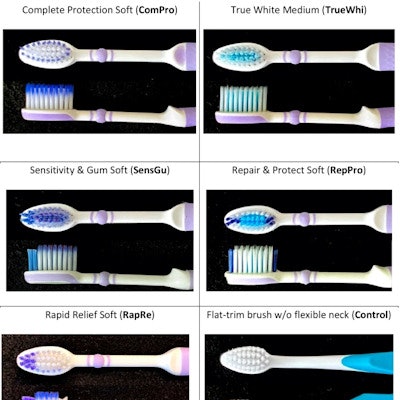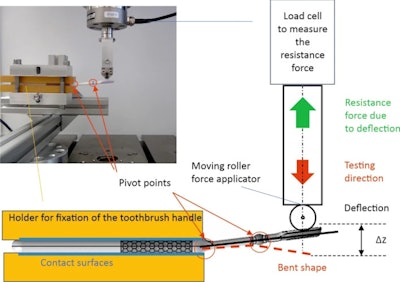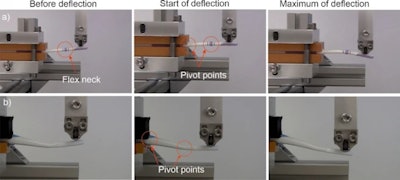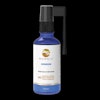
Using a toothbrush designed with a jointlike element, which makes the neck flexible, may result in patients exerting less force when cleaning their teeth, according to a new study published June 8 in BMC Oral Health.
Unlike traditional toothbrushes, flexible-neck brushes bend more, providing a gentler brushing action than traditional toothbrushes. A more bendable brush could mean less damage to teeth and gums, the authors wrote.
"The novel toothbrush designs, with the addition of a flexible component in the neck of the test toothbrushes, increase neck flexibility under typical toothbrushing forces," wrote the authors, led by Peter Gaengler of the Institute for Oral Medicine at the University of Witten, Herdecke, Germany.
For brush bristles to reach a patient's dental surfaces, toothbrushes must offer some flexibility. Also, a user must apply adequate force so that plaque can be removed without damaging gums and teeth. Excessive or improper force during brushing can develop into mechanical wear on teeth, as well as gingival recession, which could lead to dentine hypersensitivity.
To compare the deflection levels as a function of the force applied between flexible-neck and rigid-neck toothbrushes, clinicians conducted mechanical tests on 10 samples of each brush type using a universal testing device.
 A schematic for the mechanical testing prototype toothbrushes. A 3D-printed, form-fitted holder and epoxy resin were used to prevent uncontrolled bending of the toothbrushes while they were in position. The holder was needed to avoid additional pivot points during testing. This provides a good representation of toothbrushing and minimizes the effect of the handle on the measurements. Images courtesy of Gaengler et al. Licensed by CC BY 4.0.
A schematic for the mechanical testing prototype toothbrushes. A 3D-printed, form-fitted holder and epoxy resin were used to prevent uncontrolled bending of the toothbrushes while they were in position. The holder was needed to avoid additional pivot points during testing. This provides a good representation of toothbrushing and minimizes the effect of the handle on the measurements. Images courtesy of Gaengler et al. Licensed by CC BY 4.0.When the same bending force was applied during testing, the toothbrush with the flexible neck showed 2.5 times lower measured force at the head than in the toothbrush with the rigid neck. The flexible neck component -- not the angle of the toothbrush head or the different leverage effects -- caused the deflection to increase, they wrote.
 Mechanical testing of (a) a toothbrush with a flexible neck and (b) a toothbrush with a rigid neck.
Mechanical testing of (a) a toothbrush with a flexible neck and (b) a toothbrush with a rigid neck.Therefore, the flexible-neck element produced lower force and a smaller moment arm, which provide softer brushing action that may curb overbrushing and related damage to the oral mucosa and tooth surfaces, Gaengler and colleagues wrote.
"This design may reduce the force transmitted from the toothbrush to dental surfaces, resulting in lower shear and compressive stresses, and consequently potentially less damage to the teeth and gums," they concluded.
Disclosure: GSK Consumer Health funded the study.




















